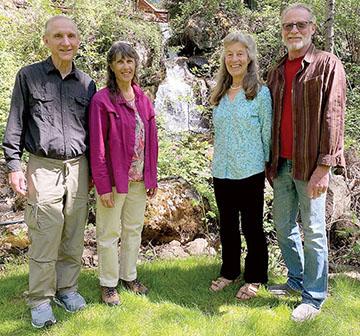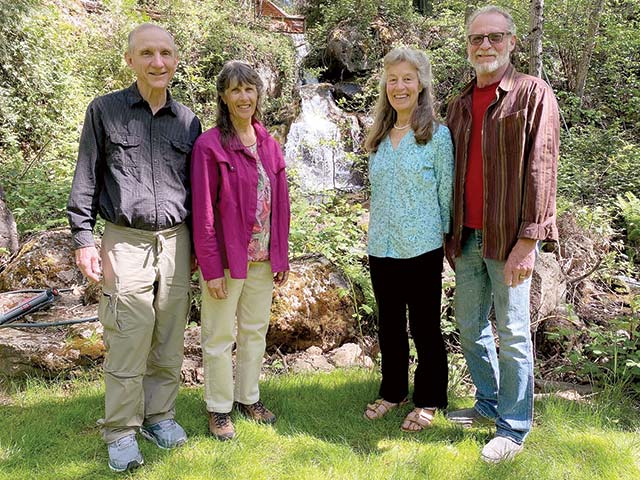By Trina Kleist
The COVID-19 pandemic has filled us all with a sense of loss, and from loss – any loss – flows grief.
When left unhealed, those feelings can fester into depression, anxiety, fear, anger and even violence, say leaders of a local nonprofit dedicated to helping people resolve loss and grief. But when we confront the feelings, notice how they play out across our lives and our relationships, seek their origins, forgive ourselves and others, make amends and resolve to live fully, those feelings fade or become manageable.

We can stop making the same old mistakes. We find new energy.
“Say hello to a new life,” says Lily Marie Mora, a long-time volunteer with Healing Through Loss and Grief Support Group. The Grief Group, as participants call it, offers a free, 14-week course twice a year through the FREED Center for Independent Living in Grass Valley. During weekly meetings, the program uses readings, lectures, large-group check-ins, small-group support, at-home journaling and other techniques to wrestle with loss.
Those willing to go to the mat can arise to live in authentic joy, says co-facilitator John R. Davidson, 67. “It’s not so much that we recover from grief. Grief recovers us from irretrievable loss,” he says. “Grief transforms us.”
Loss leads to grief, loss adds up
Death and divorce are only the most obvious forms of loss. Any change in a familiar pattern of behavior can cause the conflicting feelings that characterize grief, write experts John W. James and Russell Friedman. Their book, The Grief Recovery Handbook, is one of the resources the Grief Group uses.
The on-going coronavirus pandemic has wreaked change on all of us, says Mora, 67, who came to the group more than two decades ago when her brother died. Our faith centers and social places shut down, we isolated, we lost our jobs, we worked at home or perhaps lost our home. We became our children’s and grandchildren’s teachers, we wore masks in the grocery store. Our families and friendships frayed over ideological disagreements, and our nation exploded in violence. Our loved ones got sick, and we couldn’t visit. When they died, we couldn’t gather to mourn.
“Grief is the conflicting feelings caused by the end of or change in a familiar pattern of behavior,” write John W. James and Russell Friedman in The Grief Recovery Handbook. “While grief is normal and natural… it is also the most neglected and misunderstood experience.”
Loss piles upon loss, month after year.
“Grief is this painful kind of emotion that encompasses fear and sadness and anger. But the big thing we see now in our groups is, it’s complicated grief. The changes the pandemic has created affect almost every aspect of our lives.”
lily marie mora
From tears to joy
During the Grief Group’s 14-week course, people at first are often tense and silent. Like the layers of an onion, the events that spawned their grief peel back. Participants examine key relationships, usually in one’s childhood, for clues to the grief’s origins, and the patterns it produced. As participants work in small groups, tears flow. “Today’s overwhelming pain is really wrapped up in a whole history of losses,” says Vern Smith, 76, who facilitated courses for 20 years.
Perhaps the hardest part of examining our losses is facing the emotions they stir up, such as fear. For some, anger or sadness can dominate other feelings, says Davidson. Grief Group participants are encouraged to face them all. “Every emotion brings a gift to us, if we can understand what the emotion is and learn what it is trying to teach us,” he adds.
Participants chart key events in their lives, both positive and negative, and consider the feelings sparked by each. “We start to realize that life repeats itself,” Mora says. “If we don’t figure out the grief experience of our childhood, instead, many times, our next boss is the mean mom or dad.”
Like a clear sky after a storm, the spent emotions give way to light.
“I see this in every group,” says Smith. “They come in, and the room is just thick with grief and sadness. Then that shifts gradually. I start seeing people interacting with joy, and at the end, really, celebration.”
By the end of the program, grief released makes space for gratitude, wisdom and a new commitment to life. Participants also leave with a basket of skills for facing future losses and a network of people they can call on, Mora says.
“Grief can help us clarify our values,” Mora adds. “We’re picking up the broken pieces of ourselves, letting go of all that grief and taking back our authentic selves. We move into being the ‘empowered adult’ like never before.
“And we let that light shine.”
Local start, expanding reach

The late Marilyn Beckwith started the Grief Group in 1990. Beckwith was a therapist with a practice in Nevada City, and was blind. The trigger for starting the program was Beckwith’s husband: They married, then he died suddenly. “They used the flowers from the wedding at the funeral,” says Smith, who heard Beckwith tell this story.
Devastated, Beckwith heard the same unhelpful tropes we all hear when grief crashes over us: It was his time. She’s in a better place. You’ll get over it. Buck up.
She finally found resources, including a grief recovery program in the San Francisco Bay Area. “She realized that she could do that herself, so she created the grief group here in Nevada County,” Smith says.
“We need their wisdom. We need their experience.”
Lily Marie Mora
The success of those who have gone through the program has inspired Mora, a social worker who came to the group when her brother died, to push for its adoption in other settings. The emotional skills participants learn can help as the nation confronts the mental health crisis made worse by the pandemic, she says.
Davidson came to the group after his wife died a decade ago. Since becoming a facilitator, he has pursued additional certification in grief counseling and now has a private practice. “My soul mission is to meet people in the pain of their losses, use grief to help them transform their lives, to live in more love and less pain.”
In this latest phase of the coronavirus pandemic, 50-plus residents have a special role to play. “I would invite our older residents to be part of the solution, to learn about grief and to be open to helping with the rebuilding of our society,” Mora says.
Three Rules of Loss & Grief
- Loss is cumulative and persistent.
- Anger can be a default emotion for men, and sadness can be a default emotion for women. Both can cover up other feelings.
- At anger’s root, often, lies fear.
…………………….
RESOURCES FOR LOSS AND GRIEF
Healing Through Loss and Grief Support Group
FREED.org/services/peer-support/Grief-Group
(530) 477-3333
Certified grief recovery educator John R. Davidson
email: GoodGriefHealing.net • (530) 277-1377
